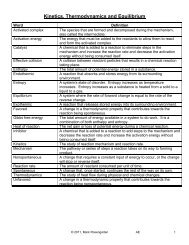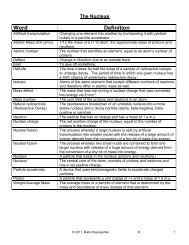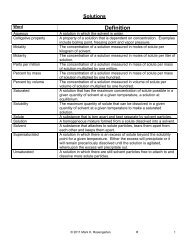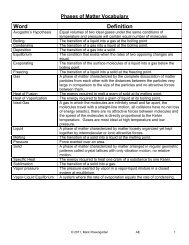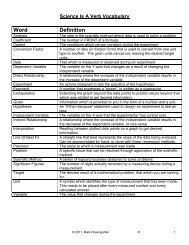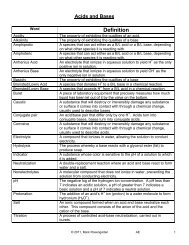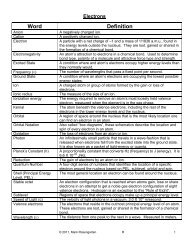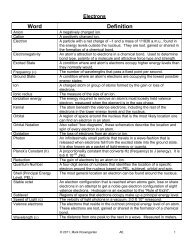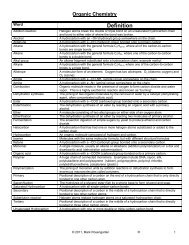Unit 11 - Mark Rosengarten
Unit 11 - Mark Rosengarten
Unit 11 - Mark Rosengarten
You also want an ePaper? Increase the reach of your titles
YUMPU automatically turns print PDFs into web optimized ePapers that Google loves.
1) Properties of Arrhenius Acids and Bases (HW: p. 13, 14)<br />
Essential Question: Which is more dangerous; an acid or base?<br />
“Oh my goodness! It’s acid! It’s gonna get you!!! It’s gonna eat you up, eat you up, eat you up!”<br />
When I took chemistry in high school, my friend Tim was a bit of a prankster. He took an eyedropper with water in it<br />
and chased a friend of his around the lab room shouting what you see above. His friend ran in fear, mortal terror that<br />
he would be eaten away by an acid. Why didn’t Tim shout “it’s a base! It’s a base!” Would his friend have run in<br />
terror?<br />
Acids and bases are a cornerstone of chemistry. These two substances have uses in industry, medicine, geology,<br />
cosmetics and in the home as well. Ammonia (NH 4 OH) is a base that is used to clean grease buildup on floors.<br />
Hydrochloric acid (HCl) is used to partially dissolve the surface of concrete flooring so that it roughens to hold floor<br />
paint better. Hydrofluoric acid (HF) is used to etch glass. Sulfuric acid (H 2 SO 4 ) is used as a catalyst for certain<br />
reactions, and as a reactant in refining iron ore. Sodium hydroxide (NaOH) is reacted with animal fat or vegetable oil<br />
to form soap, and it is also used for drain cleaner.<br />
Svante Arrhenius (1859-1927) was the first to describe the conductivity of electrolyte solutions, and to hypothesize<br />
that solutions that conduct electricity contain dissolved ions. He also described acids and bases in terms of their<br />
properties. What follows is the Arrhenius Definition of acids and bases!<br />
ACIDS: substances that contain H + ions that ionize when dissolved in water.<br />
Acids are the only molecules that ionize when dissolved in water. Acids are electrolytes, unlike other molecular<br />
substances like water (H 2 O) and sugar (C 6 H 12 O 6 ). The H leaves the acid and bonds to the water molecule to form a<br />
hydronium ion (H 3 O + ).<br />
Examples:<br />
HCl (g) + H 2 O (l) H 3 O + (aq) + Cl - (aq)<br />
The acid HCl contains 1 H + which combines with 1 H 2 O<br />
to form 1 H 3 O +<br />
H 2 SO 4 (l) + 2 H 2 O (l) 2 H 3 O + (aq) + SO 4 -2 (aq)<br />
The acid H 2 SO 4 contains 2 H + which combines with 2<br />
H 2 O to form 2 H 3 O +<br />
H 3 PO 4 (l) + 3 H 2 O (l) 3 H 3 O + (aq) + PO 4 -3 (aq)<br />
The acid H 3 PO 4 contains 3 H + which combines with 3<br />
H 2 O to form 3 H 3 O +<br />
© 20<strong>11</strong>, <strong>Mark</strong> <strong>Rosengarten</strong> R 2



